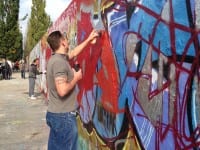Before the fall of the Berlin Wall 25 years ago, Check Point Charlie was the gateway for intrepid tourists to cross into East Berlin to witness life under the iron fist of communism.
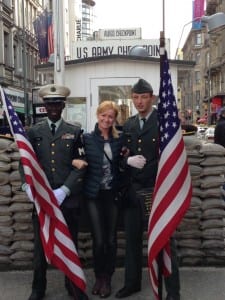
The greatest adventure I could imagine, when I was a student in Europe, was to cross the wall at Check Point Charlie. At that time, the city was defined and divided by the despised concrete wall, an international symbol of divided Germany after World War II and a symbolic boundary between Communism and Democracy during the Cold War.
I boarded a train in Luxembourg to travel, alone – my first experience traveling solo – across Communist East Germany. The adventure turned serious when, long after midnight, an officious, intimidating East German train conductor – who spoke no English, and I spoke no German – barked orders at me then took my passport.
My head tilted backwards and banged the train seat as the full weight of it hit me. I was alone, with no passport, crossing East Germany, a region trapped in the iron fist of Communism. As dawn broke, after a sleepless night, the gruff conductor returned my passport. When the train pulled into the West Berlin train station and two friends met me on the tracks, I was still shaking. Berlin was a frightening place to me. The next morning, despite my anxiety, we crossed through the barbed wire and cement barriers at Check Point Charlie and spent a disturbing, depressing afternoon in the Communist East.
Berlin today
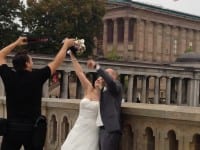
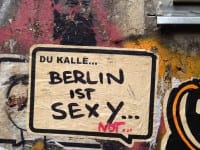

Several weeks ago I flew into a much-changed city.
Today the German capital drives the largest economy of Europe and is a magnet for capitalist businessmen, artists, intellectuals, and young students seeking a world class, affordable education.
My boutique hotel was located in the former East Berlin. For five days I walked, biked and traveled by efficient public transportation through lively neighborhoods with tree-lines streets, outdoor cafes, and sophisticated and family-owned restaurants.
The energetic vibe reminded me of the Latin Quarter in Paris or the West Village in New York City. One evening I danced until midnight at a historic ballroom. Another day I reveled in the paintings, sculptures and antiquities at the five museums on Museum Island. I dined at elegant restaurants – sampling white truffles – and tasted my way through Bohemian neighborhood street fairs and the Berlin Food Festival.
Berlin is one of Europe’s top tourist destinations
Last year Berlin attracted more visitors than Rome. After London and Paris, it is the third most popular destination in Europe.
You may wonder why. It is very affordable. Visitors from Paris, London and Brussels flock to the city for weekend getaways to indulge in the epic nightlife, sophisticated culture, concerts, and fine dining. And it is beautiful; 30 percent of Berlin is landscaped parks, lakes and forests. “It’s like New York, but more green and spread out,” Rachel, an American from Brooklyn who is studying in Berlin, told me.
History comes alive
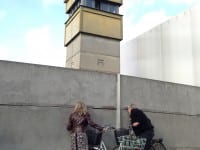

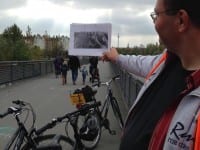 David points out the apartment where a woman jumped to her death in 1961 trying to escape from the East to the West.
David points out the apartment where a woman jumped to her death in 1961 trying to escape from the East to the West.
I pedaled into history along the wall trail, the Mauerweg, on a bicycle tour. Near the Wall Park I paused to watch young graffiti artists paint colorful murals on the wall. Then, my 39-year-old tour guide, David Weissenborn, described his family’s escape from East Berlin when he was 14 years old.
“We left under the pretense of taking a one-week vacation to Budapest, then traveled through Poland to Austria and finally settled in a refugee camp in West Germany until the wall fell,” Weissenborn said. He described his family’s controlled life before they fled. I mused that I could have passed his mother on the street when I ventured into East Berlin as a young woman.
At Bernauer Strauss, Weissenborn pointed out the many homes where residents awoke on a Monday morning in 1961 to discover a barbed wire barrier between their homes and West Berlin. Desperate to keep its citizens in, East Germany erected the 97 miles around the three western sectors of Berlin and for 28 years, it kept its citizens locked in.
The physical division between Socialist East Berlin and Democratic West Berlin began with a fence of barbed wire and quickly progressed to thick walls covered in barbed wire, a no-man’s zone, and guard stations armed with security forces authorized to shoot to kill. Thirteen hundred people lost their lives trying to escape. Most were shot by East German guards.
We pedaled to an apartment block that became part of the wall. It was here that many desperate people jumped from their windows to the freedom of West Berlin. Not far away we paused at the location where, at 11 pm on the night of November 9, 1989 the barrier was opened.
Word spread quickly, and 20,000 people crossed at this check point in 45 minutes.
Gone but not forgotten
The destruction of the wall, 25 years ago was celebrated around the world. The anniversary was celebrated on November 9, 2014 with peace celebrations and white helium balloons illuminating what is left of the wall.
Tourists flock to Check Point Charlie – the best known Berlin Wall crossing point – to have photos taken, ironically, with a neon McDonald’s sign flashing in the background. Don’t miss the outstanding DDR (Eastern Berlin) Museum where hands on exhibits explore daily life behind the wall such as spying and interrogation by the feared Stasi Secret Police.
Ever changing
I left Berlin as I had entered it, so many years ago, by train.
As the courteous instructor punched my Eurail Pass, I wished I could stay a few more days. I sat on a bench in the modern Railway Station and watched the sun rise. The glistening glass dome over the Reichstag (Parliament) Building, large cranes over new construction sites and the striking architecture of the Potsdamer Platz dominated the skyline. The story of Berlin is equally about its historic past and its ever evolving, vibrant future.
For more information visit: www.VisitBerlin.de, Berlinonbike.de, www.Eurail.com
